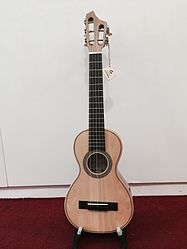 5-string rajão 5-string rajão | |
| String instrument | |
|---|---|
| Classification | String instrument |
| Hornbostel–Sachs classification | (Composite chordophone) |
| Developed | Madeira, Portugal |
| Related instruments | |
| Ukulele, cavaquinho, timple | |
The rajão (Portuguese: machete de rajão) is a 5-stringed instrument from Madeira, Portugal. The instrument traces back to the country's regional folk music, where it is used in folklore dances of Portugal in addition to other stringed instruments from the same region.
History
There is little information of the origins of the rajão, but it is often associated with traditional folklore dance of Madeira and the origins of the ukulele of Hawaii. As early as 1879, Portuguese immigrants (who also owned business in musical instruments) brought the rajão (as well as a viola and braga) to Hawaii, where it was later given the nickname of the "taro-patch fiddle." The rajão can be known as the "mother of the ukulele."
Construction and tuning
The instrument is about 70 centimeters (about 2 feet and 3 inches) in length and can be compared to a guitar with regards to structure and playing technique. On a modern rajão the strings are made of metal. The rajão is tuned to D4-G4-C4-E4-A4, a reentrant tuning with the third string the lowest pitch. When it has 6 strings, the tuning becomes D4-G4-C4-E4-A4-A4. The rajão also comes with all five courses doubled, though these are less common.
Related instruments

References
- Johnson, Orme (1939). "Musical Instruments of Ancient Hawaii". The Musical Quarterly. 25 (4): 498–506. doi:10.1093/mq/XXV.4.498. JSTOR 738862.
- "History of the Ukulele". Coolhanduke.com. Retrieved 2016-09-27.
- "Rajão". Portoguitarra.com. 2014-01-21. Retrieved 2016-09-27.
- ^ "ATLAS of Plucked Instruments - Europe West". Atlasofpluckedinstruments.com. Retrieved 2016-09-27.
- Tranquada, Jim; King, John (2012). The Ukulele: A History. Hawaii: University of Hawaii, Honolulu. p. 41. ISBN 9780824835446 – via Fusion.
| Guitars | |
|---|---|
| Playing | |
| By type (six string) | |
| Additional strings | |
| Ancillary | |
| Related topics | |
This article relating to guitars is a stub. You can help Misplaced Pages by expanding it. |